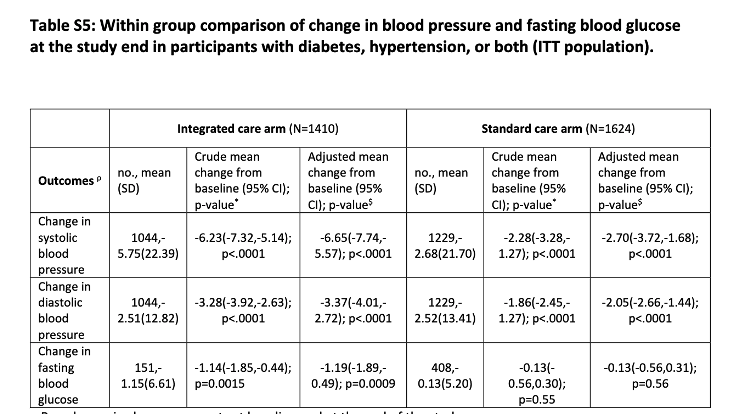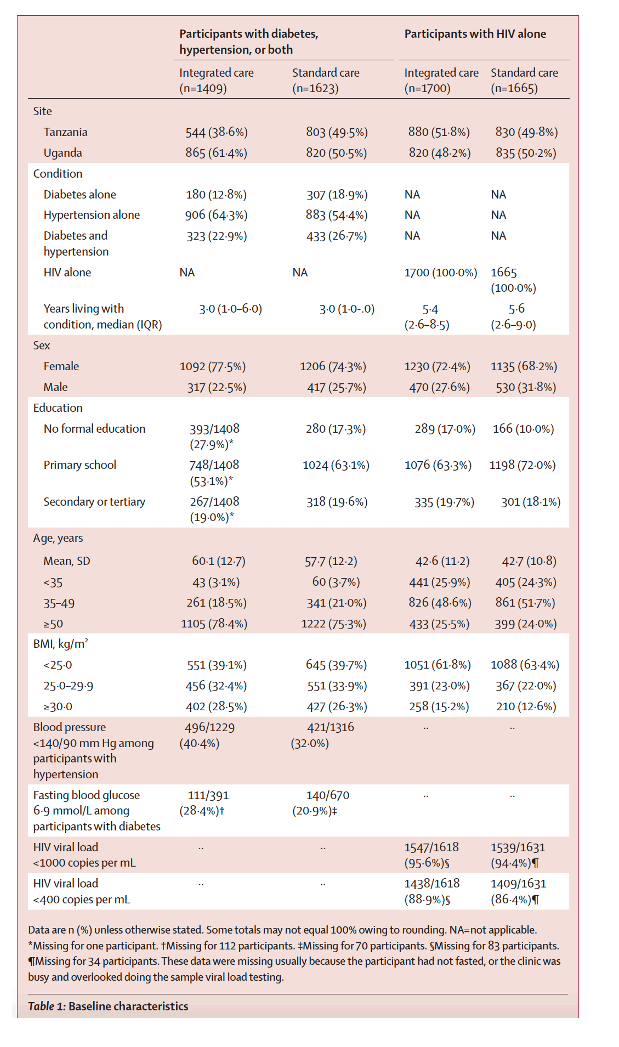| |
Integrating HIV, hypertension, and diabetes primary care in Africa
|
| |
| |
Download the PDF
Download the PDF
Download the PDF
Integrated management of HIV, diabetes, and hypertension in sub-Saharan Africa (INTE-AFRICA): a pragmatic cluster-randomised, controlled trial
a dramatic wave of non-communicable diseases (NCDs) in Africa threatens to reverse the health gains made by combating HIV…..this landmark trial demonstrates that integration of services for NCDs into existing HIV primary care clinics has the potential to achieve excellent NCD outcomes without compromising HIV care, and could save both money and time for people living with multimorbidity.
According to WHO global health estimates, NCDs accounted for 17 million premature deaths in 2019, and 86% of these premature deaths occurred in lower-income countries. NCDs are projected to be the most common cause of premature death in Africa by 2030.
Control of hypertension and diabetes in sub-Saharan Africa has been a huge challenge. We are probably where we were with HIV control in sub-Saharan Africa 20 years ago, but face a bigger challenge going forward, as the burden of non-communicable conditions is very high. Our research shows a pathway for tackling these conditions and bringing down their associated mortality, while maintaining good outcomes for people with HIV.
The obvious questions are what can be learned from the highly successful HIV programmes in Africa to address the growing problem of NCDs, and can we build on existing HIV infrastructure to address NCDs without compromising HIV programmes? These questions have been reverberating but, until now, we did not have the clinical trial evidence to answer them.6, 7
Summary
Background
In sub-Saharan Africa, health-care provision for chronic conditions is fragmented. The aim of this study was to determine whether integrated management of HIV, diabetes, and hypertension led to improved rates of retention in care for people with diabetes or hypertension without adversely affecting rates of HIV viral suppression among people with HIV when compared to standard vertical care in medium and large health facilities in Uganda and Tanzania.
Methods
In INTE-AFRICA, a pragmatic cluster-randomised, controlled trial, we randomly allocated primary health-care facilities in Uganda and Tanzania to provide either integrated care or standard care for HIV, diabetes, and hypertension.
Random allocation (1:1) was stratified by location, infrastructure level, and by country, with a permuted block randomisation method. In the integrated care group, participants with HIV, diabetes, or hypertension were managed by the same health-care workers, used the same pharmacy, had similarly designed medical records, shared the same registration and waiting areas, and had an integrated laboratory service. In the standard care group, these services were delivered vertically for each condition.
Patients were eligible to join the trial if they were living with confirmed HIV, diabetes, or hypertension, were aged 18 years or older, were living within the catchment population area of the health facility, and were likely to remain in the catchment population for 6 months. The coprimary outcomes, retention in care (attending a clinic within the last 6 months of study follow-up) for participants with either diabetes or hypertension (tested for superiority) and plasma viral load suppression for those with HIV (>1000 copies per mL; tested for non-inferiority, 10% margin), were analysed using generalised estimating equations in the intention-to-treat population. This trial is registered with ISCRTN 43896688.
Findings
Between June 30, 2020, and April 1, 2021 we randomly allocated 32 health facilities (17 in Uganda and 15 in Tanzania) with 7028 eligible participants to the integrated care or the standard care groups.
Among participants with diabetes, hypertension, or both, 2298 (75⋅8%) of 3032 were female and 734 (24⋅2%) of 3032 were male. Of participants with HIV alone, 2365 (70⋅3%) of 3365 were female and 1000 (29⋅7%) of 3365 were male. Follow-up lasted for 12 months.
Among participants with diabetes, hypertension, or both, the proportion alive and retained in care at study end was 1254 (89⋅0%) of 1409 in integrated care and 1457 (89⋅8%) of 1623 in standard care.
The risk differences were -0⋅65% (95% CI -5⋅76 to 4⋅46; p=0⋅80) unadjusted and -0⋅60% (-5⋅46 to 4⋅26; p=0⋅81) adjusted. Among participants with HIV, the proportion who had a plasma viral load of less than 1000 copies per mL was 1412 (97⋅0%) of 1456 in integrated care and 1451 (97⋅3%) of 1491 in standard care. The differences were -0⋅37% (one-sided 95% CI -1⋅99 to 1⋅26; pnon-inferiority<0⋅0001 unadjusted) and -0⋅36% (-1⋅99 to 1⋅28; pnon-inferiority<0⋅0001 adjusted).
Interpretation
In sub-Saharan Africa, integrated chronic care services could achieve a high standard of care for people with diabetes or hypertension without adversely affecting outcomes for people with HIV.


|
|
| |
| |
|
|
|